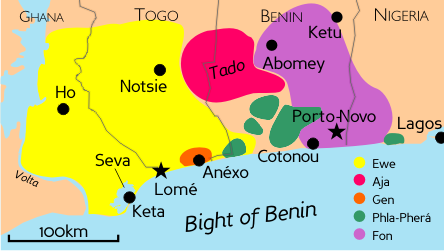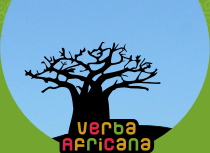The Ewe language
Ewe, also written Evhe, or Eʋe, is a major dialect cluster of Gbe or Tadoid (Capo 1991, Duthie 1996) spoken in the south-eastern part of the Volta Region of Ghana across to parts of southern Togo as far as and just across the Togo-Benin border by about three million people. Ewe, and for that matter Gbe, belongs to the Kwa family of Niger-Congo. Gbe languages are spoken in an area that extends from Lower Volta (in southern Ghana) across into Togo, Benin and as far as Western Nigeria to Lower Weme; that is, from the Greenwich Meridian to 3oE and from the Atlantic coast to about 8oN.
Ewe dialects vary enormously. Groups of villages that are two or three kilometres apart use distinct varieties. Nevertheless, across the Ewe-speaking area, the dialects may be broadly grouped geographically into coastal or southern dialects, e.g., Aŋlɔ, Tɔŋú Avenor, Dzodze, Watsyi and inland dialects characterised indigenously as Ewedomegbe, e.g., Ho, Kpedze, Hohoe, Peki, Kpando, Fódome, Danyi, Kpele etc. (Agbodeka 1997, Gavua 2000, Ansre 2000). Speakers from different localities understand each other and can identify the peculiarities of the different areas. Additionally, there is a written standard that was developed in the nineteenth century based on the regional variants of the various sub-dialects with a high degree of coastal content. With it, a standard colloquial variety has also emerged (spoken usually with a local accent), and is used very widely in cross-dialectal contact sites such as schools, markets, and churches.
The storytellers use a dialect of Aŋlɔ spoken in Seva. Their language is the spoken form and hence does not necessarily conform to the expectations of someone familiar with the standard dialect. For instance, they use the form yi to introduce relative clauses instead of the standard written si, and yia ‘this’ instead of the standard written sia. They sometimes also use subject markers on the verb agreeing with the lexical NP subject while this is not written in the standard. A distinctive feature of the Aŋlɔ dialect is that the sounds made in the area of the teeth ridge are palatalised when followed by a high vowel. For instance, the verb tsi ‘become old’ is pronounced [tsyi] by the storyteller Kwakuga Goka.
Ewe is bordered to the west by Ga-Dangme and Akan, and to the north by the Ghana-Togo-Mountain languages, for example, Siwu, Siya, Likpe etc., all Kwa languages and some Gur languages such as Kabiye. To the east are the Gbe dialects —Gen, Aja and Xwla— all of which have degrees of intelligibility with Ewe (Kluge 2000). Ewe is used as a second language in the Ghana-Togo Mountain communities (Ring 1981). It is studied as a subject at all levels of education in Ghana up to and including the tertiary level and increasingly so in Togo. Ewe together with Ga and Akan are the three most important indigenous languages in southern Ghana. In Togo, where French has been the official language, Ewe and Kabiye have been declared the two indigenous languages being promoted for official use in education, mass media, etc. Ewe is thus used for radio and TV broadcasting and in some community newspapers in both Togo and Ghana. It is also used in adult literacy programmes leading to an increasing number of publications in the language on topics of health, agriculture, and child rearing, among others (Duthie and Vlaardingerbroek 1981). English and French are present in the Ewe speaking communities in Ghana and Togo respectively. Some speakers are bilingual or multilingual in Ewe and English or French and/or other languages such as Akan, Ga, Hausa, Kabiye, Akposo, Yoruba etc. Due to contact with some of these languages, some words are borrowed into Ewe. In the story told by Madam Hodolo Atɔsu, she uses words like kɔnset ‘concert’ and flawas(i) ‘flowers’ both borrowed from English.
Phonology and morphology
Ewe is a tone language with high and non-high tonemes. Complex rising and falling tones also occur. It has a seven vowel system. Each of these has both an oral and a nasalised counterpart. There are 30 consonants including double articulated labial velar stops and bilabial fricatives written ‘ƒ’ and ‘ʋ’ that contrast with labio-dental fricatives ‘f’ and ‘v’. Similarly there is a voiced apical post-alveolar stop ‘ɖ’ which contrasts with a voiced dental stop ‘d’.
When morphemes combine, their tones may be fused in much the same way that the vowels may fuse. Tone is not customarily marked in the traditional orthography except on a few items with identical segmental forms to distinguish them. Thus è ‘2SG’ vs. e ‘3SG’ which has a High tone. Similarly lé ‘catch’ versus le ‘be.at’ which has a low tone. A practice to mark all High tones in addition to the customarily marked low tones in the orthography introduced by Duthie (1996) is gaining currency in academic linguistic writings. For technical reasons the tones are not marked on the subtitles.
Ewe syllable structure may be represented as (C1) (C2) VT (C3). Each syllable has a tone. C1 may be any consonant except r, C2 a liquid as in ƒle ‘buy’, tró ‘twist’; or a palatal or a labial velar approximant as in tíá ‘choose’ and sue [swe] ‘small’. The nucleus may be a vowel or the bilabial or velar nasal, in which case they carry tone, for example, ŋdí ‘morning’, yɔḿ~ ‘call-me’. The nucleus may also be filled by two vowels which are the same, yielding a long vowel, or different, yielding a diphthong. For example: dzaa ‘welcome’, kpáò ‘no’, yoo ‘OK’. C3 is only filled by a nasal as in sɔ́ŋ ‘several’, kampé ‘scissors’, kranté ‘machete’.
Morphologically, Ewe is isolating with agglutinative features. It makes use of compounding as well as reduplication and triplication and affixation processes in the formation of new words.
Nouns have a non-high tone vocalic prefix à- or è- which are relics of Proto-Niger-Congo noun class markers. The è- prefix tends to be elided when the noun is not said in isolation, e.g., a-me ‘prefix-person’ (e-) gli ‘prefix-folktale’. Some temporal nouns have a High tone prefix and they are never elided, égbe ‘today’, éto ‘tonite’, and ázɔ ‘now’. Ewe has ideophones — a set of sound symbolic words with interesting phonological and syntactic properties — some of which code manner (of motion) concepts. Westermann (1930:107-109) gives forty ideophones that can be used in collocation with the general motion verb zɔ ‘move, travel’, “according to the manner of going” (Westermann 1930:107).
Grammar
Dependent and embedded clauses may be introduced by connectives. They fill the first position in the clause preceding all the other elements. Ewe has utterance final particles which signal illocutionary force or the attitude of the speaker. Some of the particles used in the stories are: à ‘propositional question’ ɖé ‘a tag for confirmation, question’, sea ‘you hear’. (Ameka 1998).
In Ewe, who does what to whom is expressed by constituent order where the doer comes first followed by what is done (the verb) followed by the one to whom it is done (the object). This can also be followed by the recipient action. It is therefore an SVO language.
There is also a logophoric pronoun ye (plural yewó) which is used in reportive contexts to designate the individual(s) (except for the first person) whose speech, thoughts, feelings and so on are reported or reflected in the linguistic context in addition to personal pronouns which are distinguished for subject and non-subject. The reflexive is formed by juxtaposing an independent pronoun (including the logophoric) to the noun ɖókui ‘self’, e.g. É-bé ye-si ye ɖókui ‘she said that she (LOG) cut her (LOG) self’. Similarly, the reciprocal comprises a plural independent pronoun and nɔe-wó ‘reciprocal-PL’.
Clausal negation is marked by a discontinuous negative morpheme: mé .... o. Mé occurs just before the VP and tends to be cliticised onto the first element in the VP while o occurs at the end of the clause but before sentence final utterance particles.
There are particles for framing discourse. A scene-setting expression may be preposed to the clause, and separated from the rest by a pause and/or marked by a particle lá or ɖé. If the preposed constituent is coreferential with a core argument of the clause, their relationship is indicated by an anaphoric pronoun in the clause. An argument of the clause may be front-shifted to the pre-core clause position for focus, that is before the subject slot but after the preposed constituent slot. The fronted element is marked by an argument focus marker -(y)é. Typically a gap is left in the slot within the clause structure where the fronted element would have occurred.
Ewe has a speaker-anchored two-basic demonstrative system with dialect variants: a proximal (sia, yi, ke) and a distal (kemá, má, kemí). The distal forms can be augmented by the suffixation of -i ‘deictic’ to get kem ‘that yonder’ or má ‘that yonder’ or by the adverbial particle ∂á ‘in.the.distance’: kemí ɖá ‘that in the distance’. The distal terms have truncated forms kem, m which are always accompanied by a gesture either a manual, lip or head point. In a presentational construction, obligatorily accompanied by a gesture, the demonstrative terms occur by themselves as predicates as in Kofí-é-má ‘That/There is Kofi’ (Coastal) or Nye-é ke ‘Here I am/This is me’ (Inland). In the standard dialect, however, the focused NP and the demonstrative predicate are linked by the equative copula nyé ‘be’. In addition, the predicate has to be the pronominal form of the demonstrative as in Kofí-é nyé é-má ‘That/There is Kofi’.
Ewe is an aspect rather than a tense language. Habitual aspect is the only category marked on the verb by a toneless suffix (n)a which inherits its tone from the preceding syllable. Preverbal markers express various modal and aspectual categories such as vá ‘ventive, eventually’.
A bare verb or the aorist form has a past semantics. For active verbs this signals a past occurrence of the action. For inchoative verbs it indicates the prior occurrence of the change of state, hence the state is current. The POTential can have future time interpretation in context. All these temporal interpretations can be reinforced by adverbials. The POTential and the SUBJUNCTive are mutually exclusive with the HABitual.
Ewe has several multiverb constructions. A serial verb construction (SVC) is a sequence of two or more verb phrases (including any complements and adjuncts) without any marker of syntactic dependency used to express what constitutes one state of affairs. The VPs in the sequence occur within the same temporal frame, share the same mood (e.g. imperative) and can be formally marked for different aspect categories. The individual verbs can function as independent verbs in simple clauses (in the same form). All VPs in the series have one syntactic subject which is expressed only once on VP1. The VPs cannot be formally independently negated but they can be individually focused or questioned. There is no limit on the number of VPs that can constitute a SVC, except for restrictions on production and comprehension, e.g. the sentence Egli tso ʋuu vadze lãwo dzi used to introduce the characters into the headless crab story is an SVC. The single subject is egli ‘story’; the first verb is tsó ‘get.up’ modified by the adverb ʋuuu ‘a long time’. The second verb is dze ‘contact’ modified by the preverb vá ‘ventive’.
Map
 By Mark Dingemanse (larger version,
license)
By Mark Dingemanse (larger version,
license)
Map showing the distribution of Ewe (yellow) and the other Gbe languages in Ghana, Togo, Benin, and Nigeria. Seva, the place where the Ewe tales of this volume were recorded, is a small island in the Keta Lagoon.
Based on Capo
(1991).

